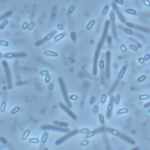Lien vers Pubmed [PMID] – 24841151
PLoS ONE 2014;9(5):e96876
Clostridium difficile is the main agent responsible for hospital acquired antibiotic associated diarrhoea. In recent years, epidemic strains have emerged causing more severe infections. Whilst C. difficile has two major virulence factors, toxins TcdA and TcdB, it is generally accepted that other virulence components of the bacterium contribute to disease. Previously, it has been suggested that flagella expression from pathogenic bacteria might be implicated in virulence. In a recent study, we observed an increased mortality in a gnotobiotic mouse model when animals were colonized with an isogenic fliC mutant constructed in the PCR-ribotype 027 (B1/NAP1) strain R20291, while animals survived when colonized by the parental strain or after colonization by other high-toxin-producing C. difficile strains. To understand the reasons for this increased virulence, we compared the global gene expression profiles between the fliC-R20291 mutant and its parental strain using an in vitro and in vivo transcriptomic approach. The latter made use of the gnotobiotic mouse model. Interestingly, in the fliC mutant, we observed considerable up-regulation of genes involved in mobility, membrane transport systems (PTS, ABC transporters), carbon metabolism, known virulence factors and sporulation. A smaller but significant up-regulation of genes involved in cell growth, fermentation, metabolism, stress and antibiotic resistance was also apparent. All of these genes may be associated with the increased virulence of the fliC-R20921 mutant. We confirmed that the fliC mutation is solely responsible for the observed changes in gene expression in the mutant strain since expression profiles were restored to that of the wild-type strain in the fliC-complemented strain. Thus, the absence of FliC is directly or indirectly involved in the high mortality observed in the fliC mutant infected animals. Therefore, we provide the first evidence that when the major structural component of the flagellum is neutralized, deregulation of gene expression can occur during infection.


